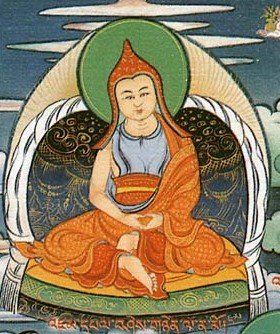Manjushrimitra: A Scholar's Odyssey at Nalanda University
Introduction: Manjushrimitra, an illustrious figure in ancient India, embarked on a transformative journey of intellectual and spiritual exploration during his time at Nalanda University. Born into an upper-class Brahmin family near Bodh Gaya, his early years were marked by both intelligence and physical charm.
Early Life and Appearance: As a youth, Manjushrimitra stood out with his handsome features—gracious and fair of skin, his appearance enhanced by the golden hue from India's daily sun. His eyes, clear and dark, added depth to his countenance, while his hair, as black as a raven's back, completed the image of a young prince.
Nalanda University: A Beacon of Knowledge: Nalanda University, situated in the ancient city of Nalanda, played a pivotal role in shaping Manjushrimitra's destiny. Renowned for its rigorous academic curriculum and diverse student body, the university was a melting pot of knowledge, attracting scholars from various backgrounds.
Academic Pursuits: Manjushrimitra's time at Nalanda was marked by a voracious appetite for learning. He delved into a myriad of disciplines, from philosophy to the sciences, engaging with a comprehensive academic curriculum that broadened his intellectual horizons. The university's esteemed faculty and diverse student community enriched his educational experience.
Philosophical Dialogues and Contributions: Nalanda University provided a fertile ground for philosophical discussions, where Manjushrimitra actively participated, engaging with renowned scholars. His keen intellect and commitment to learning set him apart, earning respect within the vibrant intellectual community. These dialogues contributed to the evolution of his own philosophical perspectives.
Spiritual Exploration: Beyond the academic realm, Nalanda was a sanctuary for spiritual exploration. The diverse teachings encountered during Manjushrimitra's time at the university laid the foundation for his deepening understanding of Buddhism. This period marked the beginning of his spiritual journey, where he sought not only knowledge but also a profound connection to the spiritual dimensions of life.
Legacy and Contributions to Buddhist Thought: Manjushrimitra's experiences at Nalanda University served as a crucible for his later contributions to Buddhist philosophy and practice. The intellectual and spiritual insights gained during his formative years played a crucial role in shaping his legacy as a revered figure in the Buddhist tradition.
Conclusion: Manjushrimitra's odyssey at Nalanda University encapsulates a transformative phase in his life, where academic pursuits, philosophical dialogues, and spiritual exploration converged. His time at this venerable institution not only molded him into a learned scholar but also laid the groundwork for his enduring contributions to Buddhist thought, leaving an indelible mark on the rich tapestry of India's intellectual and spiritual history.
Introduction: Mañjuśrīmitra, a prominent figure in Tibetan Buddhism, left an indelible mark through his profound contributions to the Dzogchen tradition. Focused on the Mañjuśrīnāmasamgīti tantric text, Mañjuśrīmitra played a pivotal role in dividing Dzogchen teachings into the three series of Semde, Longde, and Manngagde. This article delves into his key works, including the quintessential testament to his principal disciple, Sri Singha, and the groundbreaking "Gold Refined from Ore."
Transmission of Dzogchen Teachings: In the Tibetan Vajrayana tradition, Mañjuśrīmitra is revered as the transmitter of Dzogchen teachings to Sri Singha. The "Six Meditation Experiences," concealed in a jeweled casket, stands as Mañjuśrīmitra's quintessential testament to Sri Singha, embodying the essence of the Dzogchen tradition.
Key Works: Among Mañjuśrīmitra's notable works is "Gold Refined from Ore," a masterpiece that delves into the intricacies of Dzogchen philosophy. This text, rich in symbolism and profound insights, remains a cornerstone in understanding the nuanced layers of Dzogchen teachings.
Bodhicittabhavana and the Mindstream Doctrine: Within the Bodhicittabhavana, Mañjuśrīmitra explores the concept of Mindstream (Citta-santana). He asserts that the Mental-continuum is boundless, devoid of extension or singular identity. Here, he counters and refines Nagarjuna's Madhyamaka, laying the groundwork for what would evolve into the Mindstream Doctrine in Dzogchen.
Direct Yogic Experience vs. Intellectualism: A central theme in Mañjuśrīmitra's teachings is the rejection of intellectualism, philosophy, and logic as paths to realization. He emphatically states that seekers of truth must turn to direct yogic experience for genuine realization, emphasizing the experiential aspect over theoretical understanding.
Contextualizing Dzogchen: Vajranatha contextualizes Mañjuśrīmitra within the broader spectrum of Tibetan Buddhism. Dzogchen, he notes, diverges from the Chittamatra Doctrine of the Yogacharins, though some terminology may overlap. Mañjuśrīmitra's book on Garab Dorje's teachings from the Yogachara perspective adds complexity to the relationship between Dzogchen and Yogachara.
Conclusion: Mañjuśrīmitra's legacy in the Dzogchen tradition is multifaceted, encompassing intricate tantric texts, philosophical refinements, and a profound emphasis on direct experiential realization. His influence extends beyond doctrinal boundaries, contributing to the rich tapestry of Tibetan Buddhism. As practitioners today explore the depths of Dzogchen, they stand on the shoulders of luminaries like Mañjuśrīmitra, who illuminated the path to transcendental wisdom and awakening.



